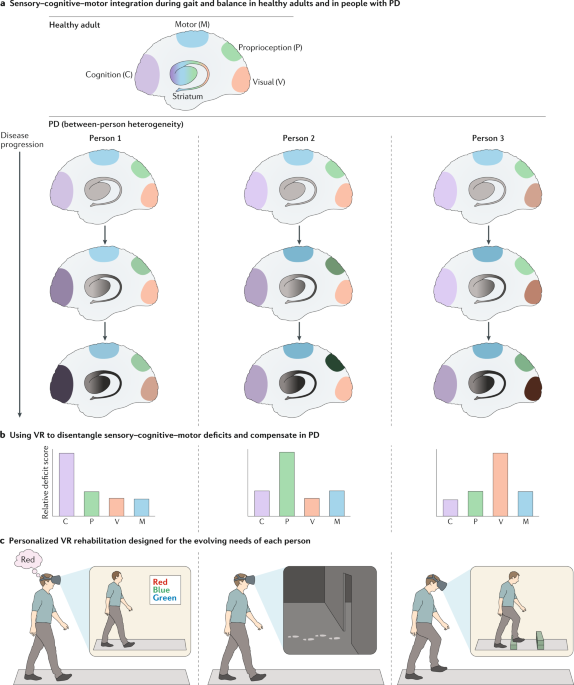
- Select a language for the TTS:
- UK English Female
- UK English Male
- US English Female
- US English Male
- Australian Female
- Australian Male
- Language selected: (auto detect) - EN
Play all audios:
Virtual reality (VR) technology has emerged as a promising tool for studying and rehabilitating gait and balance impairments in people with Parkinson disease (PD) as it allows users to be
engaged in an enriched and highly individualized complex environment. This Review examines the rationale and evidence for using VR in the assessment and rehabilitation of people with PD,
makes recommendations for future research and discusses the use of VR in the clinic. In the assessment of people with PD, VR has been used to manipulate environments to enhance study of the
behavioural and neural underpinnings of gait and balance, improving understanding of the motor–cognitive neural circuitry involved. Despite suggestions that VR can provide rehabilitation
that is more effective and less labour intensive than non-VR rehabilitation, little evidence exists to date to support these claims. Nevertheless, much unrealized potential exists for the
use of VR to provide personalized assessment and rehabilitation that optimizes motor learning in both the clinic and home environments and adapts to changes in individuals over time. Design
of such systems will require collaboration between all stakeholders to maximize useability, engagement, safety and effectiveness.
Virtual reality (VR) might provide unique opportunities to improve understanding of the behavioural and neural underpinnings of gait and balance in people with Parkinson disease.
VR environments can be manipulated in ways that are not possible and/or safe in the real world, with the potential to improve assessment and training of multisensory motor–cognitive
integration.
Non-immersive VR rehabilitation improves gait and balance when compared with no intervention, but is not superior to non-VR rehabilitation of similar exercise type and dose.
Future applications of VR should be tailored to deliver personalized interventions according to each person’s profile of deficits and rehabilitation needs.
Future developments of VR rehabilitation interventions require collaboration between therapists, technology experts and people with Parkinson disease to ensure optimal, engaging exercise
that is acceptable for long-term use.
Therapists should consider the conceptual framework, along with the pros and cons, when selecting VR paradigms to optimize training effects with carry-over into everyday activities.
M.G. is funded by the European Union’s Horizon 2020 research and innovation programme under Marie Skłodowska-Curie grant agreement No. 838576.
To identify relevant virtual reality (VR) studies we searched for articles from 1 January 2010 to 1 November 2019. A PubMed search was performed using the terms: “parkinson*” AND “virtual
reality” OR “augmented reality” AND “gait” OR “balance” OR “freezing”. The resulting 33 hits and their reference lists were screened for possible insights into the use of VR for exploring
the underlying mechanisms of gait and balance impairments in Parkinson disease. To identify relevant systematic reviews of VR interventions, a PubMed search was performed using the terms:
“parkinson*” AND “virtual reality” OR “virtual rehabilitation” OR “augmented reality” OR “exergam*” OR “videogam*” OR “video gam*” AND “systematic review”. From the 398 reviews we identified
11 relevant systematic reviews published in English. To identify relevant randomized controlled trials, the reference lists of all relevant systematic reviews were reviewed and relevant
randomized controlled trials were extracted. In addition, a PubMed search was performed using the terms: “parkinson*” AND “virtual reality” OR “augmented reality” OR “exergam*” OR
“videogam*” OR “video gam*” AND “random*”. These two strategies yielded a total of 828 articles including 17 relevant randomized controlled trials published in English.
C.G.C., N.E.A., S.S.P. and M.G researched data for the article, made a substantial contribution to discussion of content, and wrote and reviewed/edited the manuscript before submission. E.N.
and A.N. made a substantial contribution to the discussion of content, and wrote and reviewed/edited the manuscript before submission.
Nature Reviews Neurology thanks Giuseppe Riva and the other anonymous reviewer(s) for their contribution to the peer review of this work.
Springer Nature remains neutral with regard to jurisdictional claims in published maps and institutional affiliations.
Anyone you share the following link with will be able to read this content:




